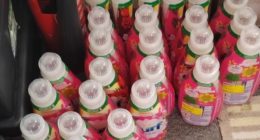
In the early 1980s, Melvin Whitfield was working for a health nonprofit in West Africa when he came to a realization: Few of the children he encountered had dolls, and the dolls he did see were modeled after white European faces and bodies.
Mr. Whitfield, who is Black, returned to Washington in 1983, around the time his girlfriend, Loretta Thomas, was coming to to her own doll-inspired despair after trying to find a toy for her niece.
It was the height of the Cabbage Patch Kids craze, and toy stores were filled with their cherubic white faces; the few Black dolls scattered among them were made with the same shape and features, but used brown fabric.
The Whitfields, who married in 1984, decided to design an alternative to the Cabbage Patch Kids. After three years of development and experimentation, they released Baby Whitney, one of the first realistic mass-produced Black dolls.
“The doll is the byproduct of their collective revulsion at what they regarded as an ‘endless parade of distorted, phony, and demonic images’ of Black children passed off as dolls,” read a sheet attached to the back of the doll’s cardboard box.
There were other Black dolls on the market that had similar aspirations to authenticity, but Baby Whitney stood out for its high quality and its makers’ close attention to detail.
“The Whitfields’ Baby Whitney was ahead of its time in mass-producing a baby doll that wasn’t just a white doll colored brown, but a doll that little Black girls could truly identify with,” Debbie Behan Garrett, an expert on the history of Black dolls, said in an interview.
Ms. Whitfield, who died on Dec. 27 at 79 at her home in Washington, had a master’s degree in psychology and had spent most of her career as a counselor at Howard University. It was that background, her husband said, that drove her passion for creating Baby Whitney.
“We felt it was necessary to take our money and go from scratch to create a real doll that would make a contribution to our culture,” Mr. Whitfield — who confirmed his wife’s death, from complications of Alzheimer’s disease — said in an interview. “We wanted to make a statement without using words.”
Loretta Mae Thomas was born on Feb. 17, 1941, in Wellington, Kan. Her family moved to Washington after her father, Jesse, got a job as a clerk at the Pentagon. Her mother, Verna Mae (Hayden) Thomas, also worked for the federal government.
Loretta entered Eastern High School in 1954, the same year the Supreme Court struck down school segregation in Brown v. Topeka Board of Education. Dolls played an important part in that case: Thurgood Marshall, the lead lawyer, relied on research by the psychologists Kenneth and Mamie Clark that showed Black children had a preference for white dolls — evidence that segregation taught them that being Black meant being inferior.
She graduated magna cum laude from Howard University in 1962 and later received a master’s in psychology from American University in Washington.
The Whitfields were not the only people in the mid-1980s thinking about Black dolls, said Fath Davis Ruffins, a curator at the Smithsonian Institution and an expert in Black consumer culture.
In 1968 Mattel began selling Christie, marketed as a Black friend to Barbie. In 1980 Kitty Black Perkins, one of the company’s few Black product designers, created the first Black Barbie, complete with an Afro.
And in the late 1970s, Ms. Ruffins said, Black artists had already begun selling handmade Black dolls with realistic features at markets and art fairs. A few other entrepreneurs had even sold mass-produced dolls like Baby Whitney.
But none had gone as far as the Whitfields. Rosalind Jeffries, a historian of African art whom the Whitfields hired to design the doll’s face, based it on the flat, disk-shaped heads of the Akuaba dolls of the Ashanti people of West Africa. Baby Whitney’s eyes, lips and nails were hand-painted, and her outfits were designed by Ms. Whitfield. Friends and neighbors helped with the painting and sewing.
Mr. Whitfield worked on the dolls full time while Ms. Whitfield continued her work as a counselor at Howard. She retired in 1999 as the director of the university’s educational advisory center. In addition to her husband, she is survived by a brother, Jesse Thomas.
The Whitfields, who operated under the name Lomel Enterprises, made only 3,500 dolls over their decade in business, selling mostly through mail order and gift shops.
Still, Baby Whitney was a hit. The Whitfields regularly sold out their production runs, and they expanded their line to include different outfits.
“We had situations where adults would come back to us and buy a second doll because they wouldn’t let their kids play with the first,” Mr. Whitfield said.
The doll was considered sufficiently lifelike that several of them were used as stunt dummies in a 1989 episode of “Rescue 911,” in which infants were dropped from a burning apartment complex.
The Whitfields stopped production in the mid-1990s to care for ailing parents, Mr. Whitfield said. It didn’t help that their undercapitalized two-person operation demanded an enormous amount of work, especially when they were negotiating with a manufacturer halfway around the world.
Nevertheless, the Whitfields proved to be pioneers: By the early 1990s companies like Mattel were making more dolls of color, and paying closer attention to their features.
“Kids identify with their dolls,” the Whitfields wrote, “and the dolls become their children and they become the dolls’ parents. You want the dolls to have an image with which the children can interact in a loving way.”
Source: | This article originally belongs to Nytimes.com









